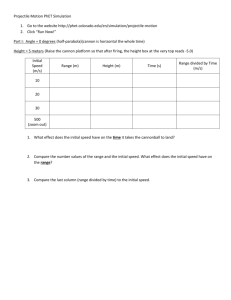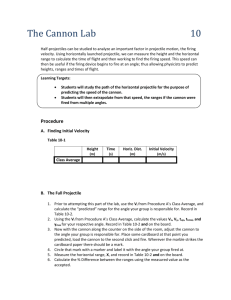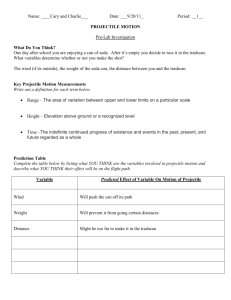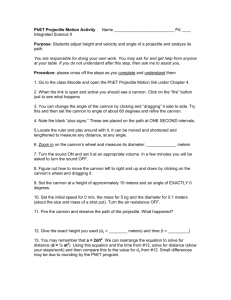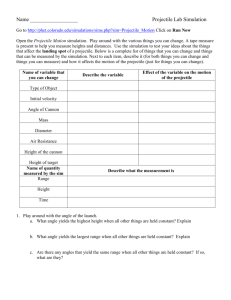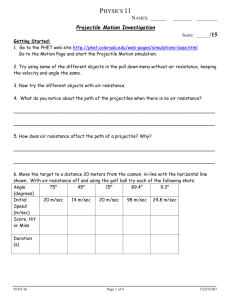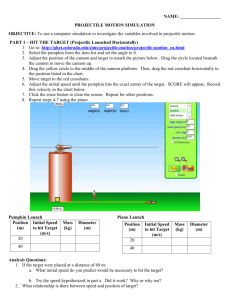PhET Sim Proj. Motion
advertisement
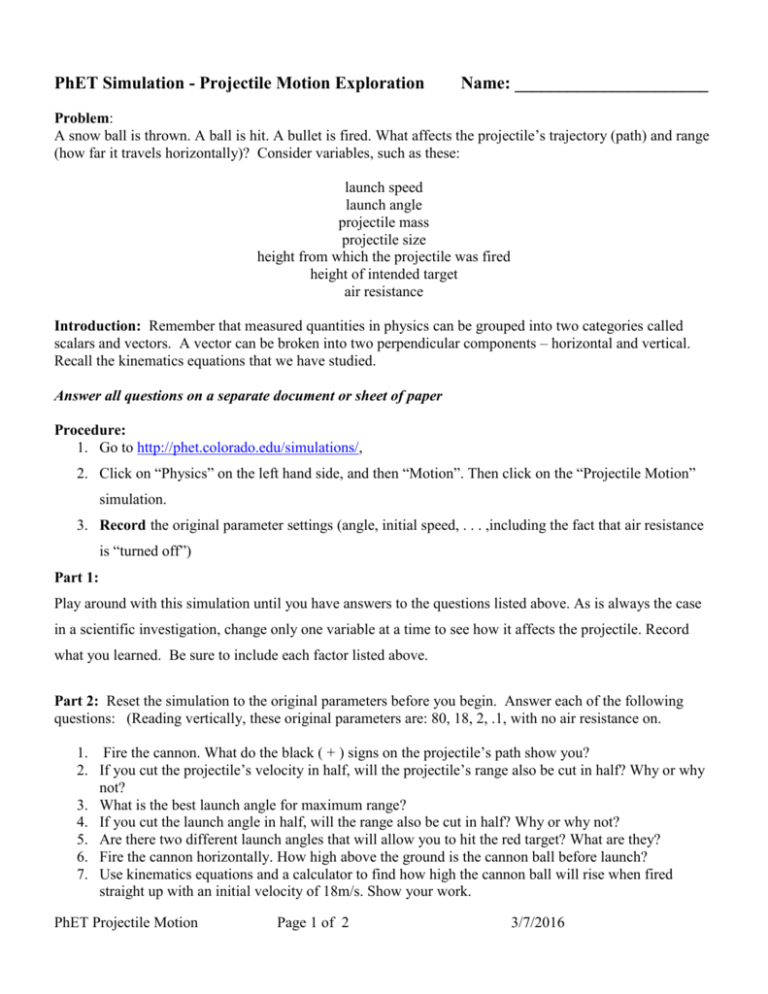
PhET Simulation - Projectile Motion Exploration Name: ______________________ Problem: A snow ball is thrown. A ball is hit. A bullet is fired. What affects the projectile’s trajectory (path) and range (how far it travels horizontally)? Consider variables, such as these: launch speed launch angle projectile mass projectile size height from which the projectile was fired height of intended target air resistance Introduction: Remember that measured quantities in physics can be grouped into two categories called scalars and vectors. A vector can be broken into two perpendicular components – horizontal and vertical. Recall the kinematics equations that we have studied. Answer all questions on a separate document or sheet of paper Procedure: 1. Go to http://phet.colorado.edu/simulations/, 2. Click on “Physics” on the left hand side, and then “Motion”. Then click on the “Projectile Motion” simulation. 3. Record the original parameter settings (angle, initial speed, . . . ,including the fact that air resistance is “turned off”) Part 1: Play around with this simulation until you have answers to the questions listed above. As is always the case in a scientific investigation, change only one variable at a time to see how it affects the projectile. Record what you learned. Be sure to include each factor listed above. Part 2: Reset the simulation to the original parameters before you begin. Answer each of the following questions: (Reading vertically, these original parameters are: 80, 18, 2, .1, with no air resistance on. 1. Fire the cannon. What do the black ( + ) signs on the projectile’s path show you? 2. If you cut the projectile’s velocity in half, will the projectile’s range also be cut in half? Why or why not? 3. What is the best launch angle for maximum range? 4. If you cut the launch angle in half, will the range also be cut in half? Why or why not? 5. Are there two different launch angles that will allow you to hit the red target? What are they? 6. Fire the cannon horizontally. How high above the ground is the cannon ball before launch? 7. Use kinematics equations and a calculator to find how high the cannon ball will rise when fired straight up with an initial velocity of 18m/s. Show your work. PhET Projectile Motion Page 1 of 2 3/7/2016 8. Fire the cannon straight up. Use the tape measure supplied, currently at the bottom of the screen, to determine the height of the ball’s trajectory above the ground. 9. Is the calculated height from the kinematics equations the same as the height of the launched cannon ball from the computer simulation? Why or why not? Part 3: Return to original parameters again. 10. Remember there is still no air resistance. If a larger cannon ball were fired instead of the tank shell, should that have an effect on the trajectory’s height or range? Does it? 11. If air resistance were turned on for the larger ball, should that have an effect on the trajectory’s height or range? Does it? Why? 12. The cannon can be raised. If the cannon were fired from an elevated position, what would be the best angle to achieve maximum range? Is it the same as the previous maximum range angle? 13. Change cannon parameters until the cannon ball hits the target. If the red target were elevated above the ground, like a basket ball hoop, which cannon parameters could you increase or decrease in order to make a “basket”? Use the simulation to see if you are correct. 14. Move the cannon to the left side of the screen. Move the cannon half way up the screen. Don’t erase the screen for the following shots. Fire the cannon horizontally. Fire the cannon several more times with progressively lower muzzle velocities. What physics principle can be learned from the black (+’s) on the multiple trajectories? 18. What new physics was learned and will be remembered from this exploration? Remember to say it well but say it briefly ! PhET Projectile Motion Page 2 of 2 3/7/2016
